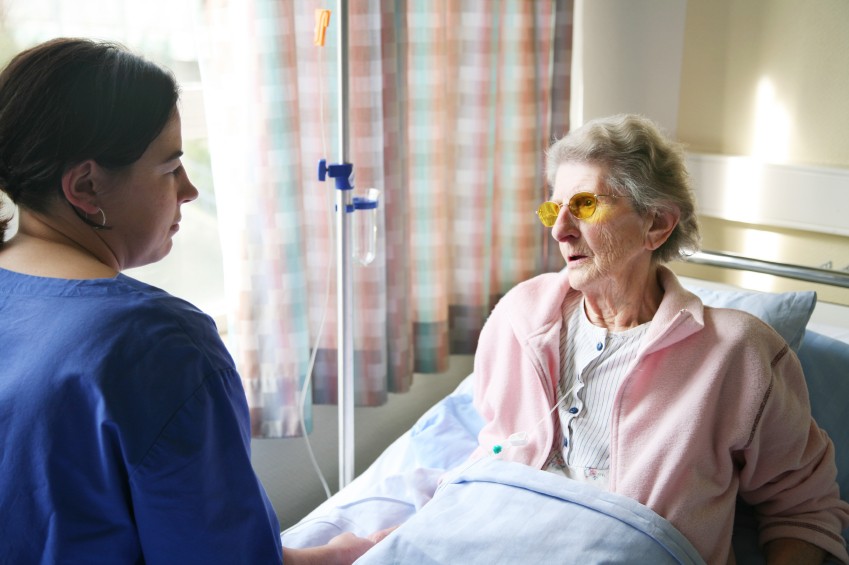 Family members with someone in long-term care need to be knowledgeable and vigilant about decubitus ulcers — the dreaded bedsores.
Family members with someone in long-term care need to be knowledgeable and vigilant about decubitus ulcers — the dreaded bedsores.
Also called pressure sores, pressure ulcers or decubitus ulcers, bedsores are skin wounds that result from prolonged pressure on the skin that’s in contact with a bed or wheelchair. Bedsores are painful, take a long time to heal and are often a precursor of life-threatening complications such as skin and bone infections.
The human body is designed to be in constant movement, even while we sleep. We constantly shift positions, always unconsciously readjusting ourselves in bed, at the computer station, watching TV or whatever active or inactive pursuit engages us.
HOW BEDSORES FORM
Bedsores form in the areas where we have the least padding of muscle and fat, especially right over a bone. The tailbone (coccyx), shoulder blades, hips, heels and elbows are common sites for bedsores. Total immobility, even for as little as 12 hours, can cause bedsores.
Circulation is impeded when blood flow slows or stops in the compressed area between bone and the surface of a bed or wheelchair. When the tissue is deprived of oxygen and nutrients, the skin can die in as little as half a day, although the evidence may not be obvious for days or even weeks.
When surgery, injury to the spinal cord, or an illness causes immobility the pressure of the immobilized body on certain areas can break down the skin. In bed, the most dangerous areas are the tailbone or buttocks and the heels. The toes, ankles, knees, hipbones, shoulders and shoulder blades, and even the rims of the ears are also at risk.
In a wheelchair, the locations at highest risk are again the tailbone and buttocks, as well as shoulder blades and the spine, and the backs of arms and legs where they touch the chair.
Problems such as arthritis or injury that make movement painful or impossible increase the probability of bedsores. Diabetics and paraplegics who have no sense of feeling in their feet are especially at risk.
Two additional causes of bedsores are shear and friction:
- Shear
Shear occurs when the skin moves in one direction and the underlying bone in another direction. Slowly sliding or slumping down in a bed or chair can cause the skin to stretch and tear. Transferring from bed to wheelchair or vice versa can also cause skin tears from shear. - Friction
Friction may also cause the skin to degrade. Even though frequent changes in position are important to prevent bed sores, the constant movement and rubbing can again break down skin. The gentlest assistance can still cause a skin wound, especially since human skin gets thinner and more fragile with age.
Good skin hydration with lotion can be helpful, and of course it is important to keep all skin clean and dry.
BEDSORE RISK FACTORS & STAGES
Age is the greatest risk factor for bedsores; the older the person, the more vulnerable their skin. In an immobilized older person, even a small skin tear, which could easily occur during routine activities such as transferring from bed to a wheelchair, might quickly develop into a bedsore. Other risk factors include smoking, lack of pain perception, urinary or fecal incontinence, malnutrition, dementia and other medical conditions such as diabetes.
Bedsores develop in stages:
- Stage I
In stage I a persistent area of red skin may itch or hurt. The spot can feel warm or spongy to the touch; conversely it may feel hard. In darker skin, the patch may look blue or purple, or appear flakey or ashen. Stage I wounds will usually disappear promptly if the pressure is relieved. - Stage II
In stage II, the skin is already compromised. An open sore that looks like a blister or abrasion is a red flag. The surrounding area may be discolored. When treated promptly, these sores can heal quickly if the person is otherwise in good health and not experiencing other problems such as diabetes or paralysis. - Stage III
Stage III bedsores are often extremely painful and difficult to treat. The pressure ulcer has extended through all the skin layers down to muscle. The deep, crater-like wound indicates permanently destroyed tissue. - Stage IV
Stage IV bedsores, the most serious and advanced stage, destroy muscle, bone, and even tendons and joints. Stage IV bedsores are often lethal.
BEDSORE PREVENTION
- Regular Re-positioning
Repositioning the body at least every two hours in bed, or every 30 minutes in a wheelchair, can help prevent bedsores, as can special beds, pillows and mattresses. However, this repositioning can cause its own problems. It is miserable to be awakened every two hours, especially if you are recovering from illness, surgery or an accident. Moving anyone every two hours, or especially every 30 minutes, is an enormous staff challenge for any facility providing personal care services, particularly in a busy hospital or nursing home. - Leg Support
Avoid lying directly on the hipbones and support legs correctly with a foam pad or pillow (never a doughnut-shaped cushion or any type of rubber pad). Put the support under the legs from the middle of the calf to the ankle and keep knees and ankles from touching. It’s helpful to have a little tent over the toes, and to use special heel pads. - Special Mattresses
Foam, air, gel or water in a bed that can be automatically or manually readjusted on a regular schedule can work well. Again, consult an expert, especially if a person is paralyzed or has other risk factors. - Inspection
Inspection is crucial to detecting bedsores in the early stages of formation, when they are much easier to cure. While this requires caregivers to get up close and personal with patients, it’s a necessary process.
BEDSORE TREATMENT
Often the situation that precipitates a bedsore makes it very challenging to treat. Conditions such as diabetes, thin skin and immobility make healing difficult. As noted, Stage I bedsores will usually disappear if repositioning is prompt and consistent. A physician’s written orders can help this happen.
Stage II, when a wound is present, calls for a multi-disciplinary approach coordinating the physician, the nurses, the aides and perhaps a physical therapist. Sometimes a social worker can help manage the personal care services provided. A careful analysis of how the wound was precipitated will help determine treatment. A change of bed, cushioning, skin care and/or clothing may be effective. Support surfaces are particularly important, and special padding such as sheepskin or waffle foam can help. Low-air-loss beds use inflatable pillows for support; air-fluidized beds suspend the patient on an air-permeable mattress that contains millions of silicon-coated beads.
There are several things that can aid with healing:
- Improved Nutrition
Dark red, orange and green vegetables are especially rich in the needed nutrients, and nutritional supplements of Vitamin C and zinc can also be helpful. - Regular Wound Cleaning & Debridement
Open sores may be treated with a saline (saltwater) solution each time the dressing is changed. Debridement is the removal of damaged tissue. Surgical debridement is often recommended to remove dead, damaged, or infected tissue. Nonsurgical treatments include irrigation with pressurized water, hydrotherapy in a whirlpool bath, using the body’s own enzymes, or applying topical debriding enzymes. - Dressings
The right bandaging can help speed healing and protect the wound. It is crucial to keep surrounding skin dry and the wound moist. Transparent, semi-permeable dressings can help retain moisture and encourage new skin to grow. Infected wounds may be treated with topical antibiotics. Again, it is crucial to also treat the pain in this difficult process.
Even with the best medical care, bedsores may require surgery. Healthy tissue may be taken from one part of the body to use in reconstructing the damaged area. Recovery is long and arduous with frequent complications. Prevention is still the best treatment.
BEDSORES & NURSING HOMES
The highest percentages of people with bedsores are in nursing homes. Some bedsores may have been acquired in the hospital, and then persisted when the person transferred to a skilled care facility. The prevalence varies from study to study, and facility to facility, but anywhere from 3 to 28% of the people in a nursing home may have bedsores.
It’s a chicken and egg situation: which came first, the bedsore or the environment? Often frail older people come to live in a nursing home because this injury is so difficult to prevent and treat at home. Sometimes the conditions that necessitate living in a nursing home, such as advanced dementia or paralysis, create the bedsore.
Article Source: http://www.aplaceformom.com/senior-care-resources/articles/bedsores

